Blog & Latest Updates
Fly Fishing Articles
Insects by Common Name


Arthropod Class Insecta (Insects)
Taxonomic Navigation -?-
1 order isn't included.
Common Name
| Match | Common Name |
| Insects |
This is page 113 of specimens of Insecta. Visit the main Insecta page for:
- The behavior and habitat of Insecta.
- 114 underwater pictures of Insecta.
Pictures of 1229 Insect Specimens:
Male Cinygmula par Mayfly Spinner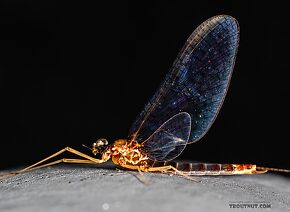 View 9 PicturesThis specimen was collected from a swarm with a female and another male.
View 9 PicturesThis specimen was collected from a swarm with a female and another male.
 View 9 PicturesThis specimen was collected from a swarm with a female and another male.
View 9 PicturesThis specimen was collected from a swarm with a female and another male.Collected July 4, 2020 from Mystery Creek #249 in Washington
Added to Troutnut.com by Troutnut on July 12, 2020
Added to Troutnut.com by Troutnut on July 12, 2020
Stenacron (Light Cahills) Mayfly Nymph View 2 Pictures
View 2 Pictures
 View 2 Pictures
View 2 PicturesCollected August 8, 2004 from unknown in Wisconsin
Added to Troutnut.com by Troutnut on January 18, 2006
Added to Troutnut.com by Troutnut on January 18, 2006
Ameletus (Brown Duns) Mayfly Nymph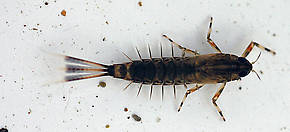 View 2 Pictures
View 2 Pictures
 View 2 Pictures
View 2 PicturesCollected March 5, 2005 from the Flathead River-lower in Montana
Added to Troutnut.com by Bnewell on June 28, 2011
Added to Troutnut.com by Bnewell on June 28, 2011
Dolichopodidae True Fly Larva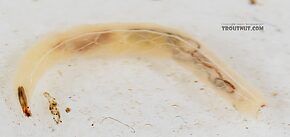 View 10 Pictures
View 10 Pictures
 View 10 Pictures
View 10 PicturesCollected July 4, 2020 from Mystery Creek #249 in Washington
Added to Troutnut.com by Troutnut on July 12, 2020
Added to Troutnut.com by Troutnut on July 12, 2020
Chironomidae (Midges) Midge Larva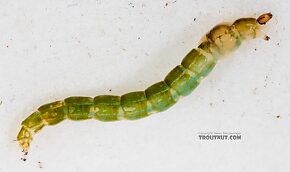 View 8 PicturesI don't see a lot of green Chironomidae larvae in my samples, so I photographed this one.
View 8 PicturesI don't see a lot of green Chironomidae larvae in my samples, so I photographed this one.
 View 8 PicturesI don't see a lot of green Chironomidae larvae in my samples, so I photographed this one.
View 8 PicturesI don't see a lot of green Chironomidae larvae in my samples, so I photographed this one.Collected July 4, 2020 from Mystery Creek #249 in Washington
Added to Troutnut.com by Troutnut on July 12, 2020
Added to Troutnut.com by Troutnut on July 12, 2020
Baetidae (Blue-Winged Olives) Mayfly Nymph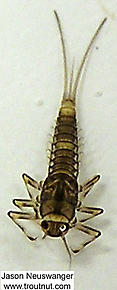 View 3 PicturesThis relatively large early March Baetid nymph has untracheated gills and no bands on its tails.
View 3 PicturesThis relatively large early March Baetid nymph has untracheated gills and no bands on its tails.
 View 3 PicturesThis relatively large early March Baetid nymph has untracheated gills and no bands on its tails.
View 3 PicturesThis relatively large early March Baetid nymph has untracheated gills and no bands on its tails.Collected March 9, 2004 from unknown in Wisconsin
Added to Troutnut.com by Troutnut on January 25, 2006
Added to Troutnut.com by Troutnut on January 25, 2006
Plecoptera (Stoneflies) Stonefly Nymph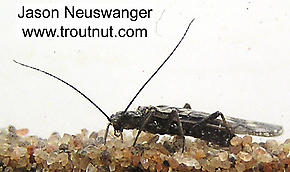 View 3 PicturesThis is a really small stonefly adult, about 3/8 of an inch body length.
View 3 PicturesThis is a really small stonefly adult, about 3/8 of an inch body length.
 View 3 PicturesThis is a really small stonefly adult, about 3/8 of an inch body length.
View 3 PicturesThis is a really small stonefly adult, about 3/8 of an inch body length.Collected April 28, 2004 from the Namekagon River, below Lake Hayward in Wisconsin
Added to Troutnut.com by Troutnut on January 25, 2006
Added to Troutnut.com by Troutnut on January 25, 2006
Female Baetis tricaudatus (Blue-Winged Olive) Mayfly Dun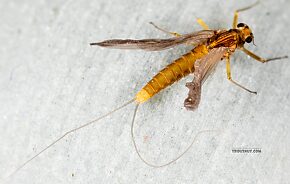 View 6 PicturesThis one emerged from a nymph of this kind in my studio but got a bit waterlogged before I could pull it out to photograph.
View 6 PicturesThis one emerged from a nymph of this kind in my studio but got a bit waterlogged before I could pull it out to photograph.
 View 6 PicturesThis one emerged from a nymph of this kind in my studio but got a bit waterlogged before I could pull it out to photograph.
View 6 PicturesThis one emerged from a nymph of this kind in my studio but got a bit waterlogged before I could pull it out to photograph.Collected September 12, 2020 from the Yakima River in Washington
Added to Troutnut.com by Troutnut on September 19, 2020
Added to Troutnut.com by Troutnut on September 19, 2020
Female Ephemerellidae (Hendricksons, Sulphurs, PMDs, BWOs) Mayfly Dun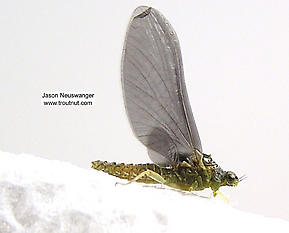 View 4 Pictures
View 4 Pictures
 View 4 Pictures
View 4 PicturesCollected August 4, 2004 from unknown in Wisconsin
Added to Troutnut.com by Troutnut on January 19, 2006
Added to Troutnut.com by Troutnut on January 19, 2006
Formicidae (Ants) Ant Adult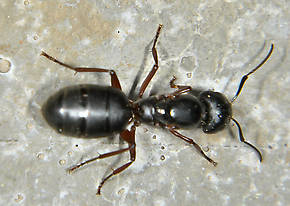 View 2 PicturesThese are very large carpenter and a common terrestrial (Terrestrial: Insects which live on land and are fed on by trout only when they incidentally fall into the water are known as "terrestrials" to fly anglers, and they're very important in late summer.) insect along mountain trout streams
View 2 PicturesThese are very large carpenter and a common terrestrial (Terrestrial: Insects which live on land and are fed on by trout only when they incidentally fall into the water are known as "terrestrials" to fly anglers, and they're very important in late summer.) insect along mountain trout streams
 View 2 PicturesThese are very large carpenter and a common terrestrial (Terrestrial: Insects which live on land and are fed on by trout only when they incidentally fall into the water are known as "terrestrials" to fly anglers, and they're very important in late summer.) insect along mountain trout streams
View 2 PicturesThese are very large carpenter and a common terrestrial (Terrestrial: Insects which live on land and are fed on by trout only when they incidentally fall into the water are known as "terrestrials" to fly anglers, and they're very important in late summer.) insect along mountain trout streamsCollected June 6, 2011 from the Touchet River in Washington
Added to Troutnut.com by Bnewell on June 26, 2011
Added to Troutnut.com by Bnewell on June 26, 2011
Top 10 Fly Hatches
Top Gift Shop Designs
Eat mayflies.
Top Insect Specimens
Miscellaneous Sites
Troutnut.com is copyright © 2004-2024 Jason
Neuswanger (email Jason). See my FAQ for information about use of my images.
 privacy policy
privacy policy
